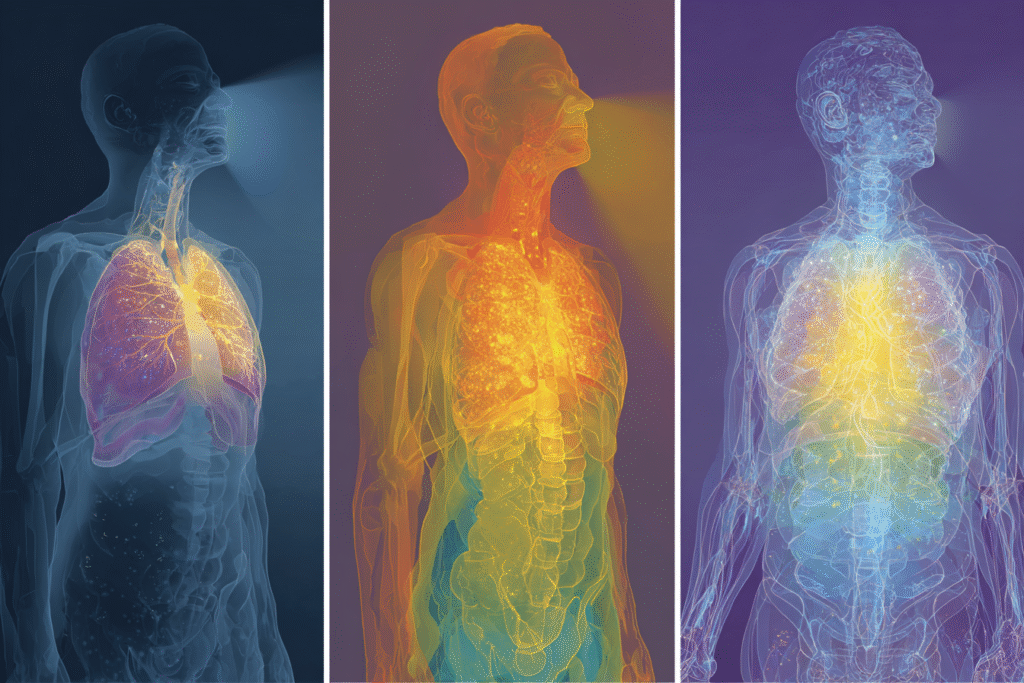Every breath is a miracle of coherence—and most of us are missing it.
Right now, as you read this, your body is performing approximately 20,000 quantum coherence events per day. We call them breaths.
The first thing you did when you entered this world was breathe. Your first breath announced your arrival into life itself. And one day, your final breath will mark your departure. Between that first inhale and last exhale lies every moment of your existence on this planet.
In survival situations, breathing comes before everything else—before finding water, building fire, seeking shelter, or locating food. Without breath, nothing else matters. Anyone who has experienced an asthma attack or struggled to breathe will tell you: in that moment, nothing exists except the desperate need for the next breath.
When someone is agitated, angry, or in an altered emotional state, what’s the first thing people instinctively tell them? “Breathe. Take some deep breaths.” This universal response reveals our collective understanding that breath is the fastest pathway back to balance and clarity.
Yet for something so fundamentally essential, most of us breathe unconsciously—missing the extraordinary transformation we carry within every inhalation and exhalation.
Each breath draws in not just oxygen, but environmental information. Each exhalation releases not just carbon dioxide, but your internal state into the world. Every breath is a two-way exchange between your quantum biology and the field around you.

This isn’t a modern discovery. Ancient practices across cultures have recognized breathing as the gateway to expanded awareness. Buddhist mindfulness meditation centers on breath awareness. Yogic pranayama has been practiced and taught worldwide for millennia.
The ancient samurai understood this depth. “Life in every breath” wasn’t just poetry to them. It was practical instruction for accessing the quantum coherence that makes everything else possible.
The Universal Gateway to Consciousness
Every spiritual tradition, every wisdom school, every consciousness practice has discovered the same entry point: the breath.
Hindu pranayama teaches that breath is the bridge between body and spirit. Buddhist vipassana uses breath awareness as the foundation for insight meditation. Taoist qigong works with breath to cultivate life energy, chi. Christian contemplatives speak of the breath of the Holy Spirit. Islamic dhikr coordinates breath with remembrance of the divine.
Modern science is validating what these traditions have known for millennia. Wim Hof has demonstrated seemingly impossible feats of human endurance—swimming under ice, climbing mountains in shorts, controlling his immune response to injected toxins—all through mastery of breathing techniques. His method shows how conscious breathing can give us extraordinary control over autonomic functions we thought were beyond conscious influence.
Even our technology recognizes this. Apple’s Health app includes breathing exercises as a core wellness feature. Smartwatches remind us to breathe consciously. Meditation apps center around breath awareness. The modern world is rediscovering what was never actually lost:
Breathing as the most accessible technology for consciousness optimization.
This convergence isn’t coincidence—it’s recognition of a universal truth: conscious breathing is the foundation that makes every other form of awareness practice possible.

When Breathing Becomes Conscious
Yesterday, we explored quantum presence—the refined awareness that emerges when traditional mindfulness deepens into subtle biological perception. Today, we discover how that presence transforms the most fundamental act of being alive.
We take breathing for granted precisely because it’s automatic. This built-in intelligence keeps us alive without our awareness—approximately 20,000 times per day, every day of our lives. But this very reliability can make us unconscious of the miracle occurring in each moment.
Conscious breathing isn’t about breathing “correctly.” It’s about bringing awareness to what’s already happening—transforming an automatic survival function into conscious participation in your own optimization.
When you breathe with presence, three things shift immediately:
Your nervous system synchronizes. Conscious breathing pulls scattered patterns into coherence, returning you to a balanced, regulated state.
Your heart learns to flow with wisdom. Coherent heart rhythms linked to conscious breath unlock emotional regulation and intuitive clarity.
Your whole system listens. With every breath, you signal that you’re safe, aware, and participating in your own evolution.
This isn’t some breathing technique—it’s breathing consciousness.
The Quantum Mechanics of Breath
Here’s what’s actually happening when you breathe consciously:
Oxygen becomes instruction. Your cells don’t just use oxygen for energy production—they use the quality of your breathing as information about environmental conditions. Calm, conscious breathing signals safety and optimization. Shallow, unconscious breathing signals stress and survival mode.
Carbon dioxide becomes calibration. CO2 isn’t just waste—it’s a signaling molecule that regulates blood flow, oxygen delivery, and nervous system state. Conscious breathing optimizes CO2 levels for maximum biological performance.
Your electromagnetic field shifts with each breath. Research shows that breathing patterns directly influence the electromagnetic field generated by your heart. This field extends several feet beyond your body, influencing not just your internal state but your environmental interactions.
Coherence spreads through your biological network. When your breathing becomes coherent, that coherence transmits through your entire system—nervous system, cardiovascular system, hormonal system, immune system. One conscious breath can initiate system-wide optimization.
Your vagus nerve becomes a superhighway. Conscious breathing activates your vagus nerve—the primary channel between your brain and body. This activation enables rapid communication between your conscious mind and your biological intelligence.
Each breath becomes a choice: distortion or coherence.

The Three Breaths That Change Everything
The most powerful breathing practice isn’t complex. It’s presence applied to what you’re already doing.
Here’s a simple practice I’ve shared with clients and collaborators alike: three breaths that can rewire your entire system in under 60 seconds.
The Recognition Breath
Place one hand on your chest, one on your belly. Take one conscious breath and simply notice what moves. No judgment, no correction—just recognition of your current breathing pattern.
Most people discover they’re breathing high in their chest, shallow and quick. This isn’t wrong—it’s information. Your system is telling you something about its current state.
The Coherence Breath
Keep your hands in place. Take a slow breath in for 4 counts, focusing on expanding your belly rather than your chest. Hold for 2 counts. Exhale for 6 counts, again focusing on your belly contracting.
This isn’t about perfect technique—it’s about shifting from automatic to conscious. You’re not just changing how you breathe; you’re changing how consciously you participate in breathing.
The Integration Breath
Remove your hands. Take one more breath, this time with the intention of sending coherence throughout your entire system. Breathe as if you’re breathing for your whole body, not just your lungs.
This breath often feels different from the others—fuller, more connected, more alive. This is what it feels like when breathing becomes conscious technology rather than unconscious function.
Three breaths. Recognition, coherence, integration. This sequence can shift your entire biological state in under a minute.
Breathing with the Field
Once you’ve established conscious breathing, you start noticing something remarkable: your breathing changes in different environments.
Walk into a tense meeting, and your breathing automatically adjusts to the field. Enter a calm, beautiful space, and your breathing naturally deepens. Move from a cluttered room to an organized one, and your breathing finds a different rhythm.
Consider walking into your workplace on a Monday morning versus a Friday afternoon. Your breathing automatically shifts to match the collective energy—tighter and more focused at the week’s beginning, more relaxed as the weekend approaches.
Or notice how your breath changes when you’re around certain colleagues—some people’s presence allows your breathing to deepen naturally, while others create subtle chest constriction you might not consciously notice.
You walk into a room where someone just argued. No words are needed—your body already knows. Your breath tightens slightly, your chest constricts. That’s your quantum biology reading the energetic field. Conscious breath is how you choose how to respond—rather than react—to that unseen information.
This isn’t imagination—it’s quantum field interaction.

Your breathing system is constantly reading and responding to environmental information that your conscious mind doesn’t detect. Learning to breathe consciously means learning to sense and respond to these environmental fields intentionally rather than reactively.
In stressful environments: Conscious breathing becomes a way of maintaining your internal coherence regardless of external chaos. You’re not trying to change the environment—you’re maintaining your optimal state within it.
In supportive environments: Conscious breathing amplifies the positive field effects. You’re not just receiving the environment’s coherence—you’re contributing to it.
In neutral environments: Conscious breathing allows you to establish the field quality you want to experience. Your conscious breathing becomes an environmental influence for yourself and others.
This is how breathing becomes environmental technology.
The Breath-Body Interface
As your breathing becomes conscious, you start noticing how it connects to everything else in your system.
Energy follows breath. Where you direct your conscious breathing, energy flows. Breathe into your heart area with intention, and you can feel energy gathering there. Breathe into areas of tension, and you can feel them beginning to release.
Emotion responds to breath. Anxiety, excitement, calm, focus—all emotional states have breathing signatures. By breathing consciously, you can influence your emotional state in real-time rather than being at its mercy.
Mental clarity follows breathing quality. Scattered breathing creates scattered thinking. Coherent breathing creates coherent mental states. Your thinking literally becomes clearer when your breathing becomes conscious.
Physical performance optimizes. Athletes have known this for centuries—conscious breathing is the foundation of physical excellence. When breathing becomes conscious, everything your body does becomes more efficient.
Intuitive access increases. Perhaps most remarkably, conscious breathing seems to increase access to information beyond ordinary thinking. The calm, coherent state created by conscious breathing is the same state in which insights, creativity, and intuitive guidance most easily emerge.
Your breath becomes the bridge between conscious intention and biological optimization.
These shifts aren’t theoretical—you can track them in your own body. Every emotional state has a distinct breathing pattern.

Breathing Signatures of Emotion
Your emotional state speaks through your breath—often before you’re even aware of how you feel.
Anxiety → Fast, shallow chest breaths
Grief → Long sighs, breath-holding
Calm → Slow, even diaphragm breathing
Focus → Rhythmic, steady breath
Joy → Full, expansive inhales
By noticing the rhythm of your breath, you gain a direct path to understanding and reshaping your internal state.
When Coherence Becomes the Default
Here’s what many people discover after 2-4 weeks of consistent conscious breathing practice: it becomes effortless.
Within the first week, you’ll notice moments when your breathing naturally deepens without conscious effort. By the second week, your system begins automatically choosing coherent breathing during mildly stressful situations.
By the fourth week, you may find yourself waking up breathing more consciously than you once did while concentrating.
This is when breathing transforms from practice to way of being.
This isn’t about perfection. It’s about integration. Your body begins choosing coherence not because you force it, but because it finally remembers how.
Life in Every Breath
The samurai phrase “life in every breath” points to something profound: when breathing becomes fully conscious, each breath contains your entire experience of being alive.
This understanding transcends culture and time. From the first breath that announced your arrival in this world to the final breath that will mark your transition from it, every moment of your existence is bracketed by breath. Between these bookends lies the opportunity to transform the most essential human function into conscious technology.
Not because breathing is everything, but because conscious breathing connects you to everything else—your emotional state, your physical condition, your mental clarity, your environmental awareness, your intuitive access, your connection to the present moment.
In survival training, they teach the rule of threes: you can survive three weeks without food, three days without water, three minutes without air. But in the moment when breath is threatened—whether through asthma, drowning, or any breathing emergency—these timeframes collapse into irrelevance. Nothing matters except the next breath.
This urgency reveals breath’s true priority: it’s not just one biological function among many, but the foundation upon which all other functions depend.
In this breath: the integration of your biological intelligence with your conscious intention.
In this breath: the foundation that makes every other quantum biology optimization possible.
This is why conscious breathing isn’t just another wellness practice—it’s the technology that makes all other consciousness technologies accessible.

Starting Today
Begin with the three breaths: recognition, coherence, integration.
Do this sequence once when you wake up, once in the middle of your day, once before sleep. Not as a rigid practice, but as a conscious check-in with the quantum biological system you are.
Notice how your breath responds to different environments, people, and activities. Don’t try to control these responses—just observe them with curiosity.
Pay attention to the moments when breathing naturally becomes conscious without your effort. These moments will increase as your system learns to prefer coherence.
Remember: you’ve been breathing for your entire life. Now you’re learning to breathe consciously.
Every breath is an invitation to remember the quantum coherence you’ve always been.
See you in the next insight.


